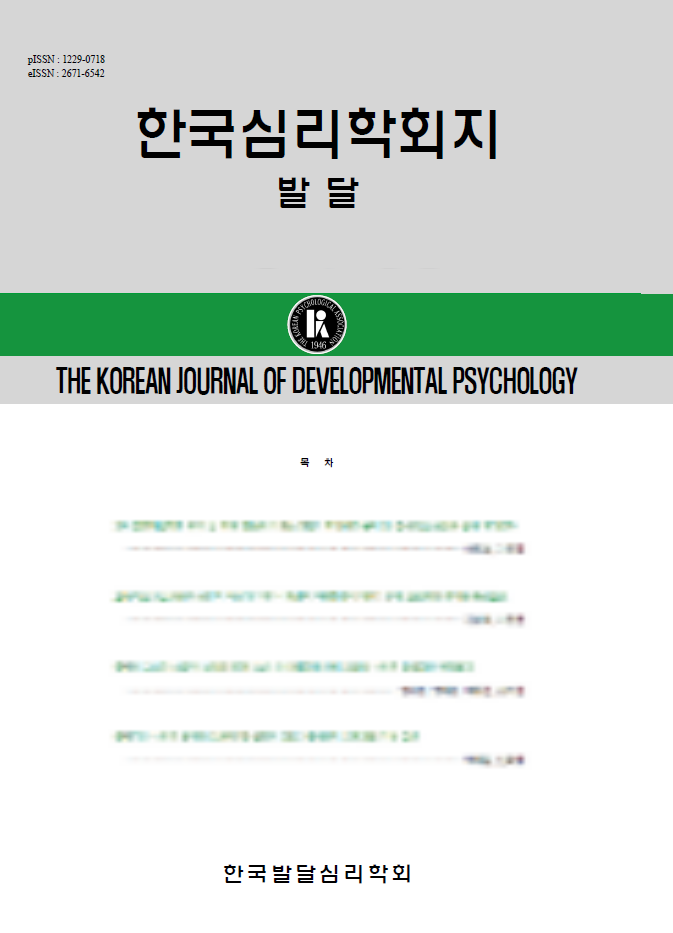open access
메뉴
open access
메뉴 ISSN : 1229-0718
ISSN : 1229-0718

본 연구에서는 아동이 정신 현상과 물리 현상을 어떻게 이해하는지를 두 개의 연구를 통해 밝혀 보고자 하였다. 연구 1에서는 아동들에게 물리적 실체와 정신적 실체를 지각가능성, 공공성, 존재의 지속성, 무게의 4개의 기준에 근거하여 구별할 수 있는지를 살펴보았다. 결과는 3세 아동들은 이 두 실체를 구별하는 수행이 다소 낮았으나 5세 이후에는 이 두 실체를 구별하는 수행이 현저하게 증진되는 것을 볼 수 있었다. 연구 2에서는 이해하기 쉬운 물리적 특성을 가지는 물리 대상(예, 꽃, 자동차), 이해하기 어려운 물리적 특성을 가지는 물리 대상(예, 공기, 열, 그림자, 등), 소리로 지각할 수 있는 물리 대상(예, 소리, 메아리)등을 짝을 지어 제시하고, 이 자극들을 지각가능성, 무게, 존재의 지속성, 물리적 공간 차지, 상호작용 가능성의 5 개의 기준에 근거하여 분류하도록 하였다. 또한 분류한 이유를 설명하게 하였다. 그 결과 7세 이후의 아동들은 제시된 기준에 근거하여 자극들을 비교적 정확하게 분류하였지만 분류한 이유를 정확하게 설명하지는 못했다. 하지만 아동들이 설명한 내용을 분석했을 때 연령이 증가하면서 지식의 변화가 일어나고 있음을 볼 수 있었다.
This study attempted to explore whether Korean children could understand the ontological distinction between the mental entities and physical entities through two studies. We used eighty 3-, 5-, 7-, 9-, and 11-year-old children(16 for each age group). In the first study, children were asked to judge the properties about the mental entities as well as the physical entities according to four different kinds of criteria such as behavioral-sensory contact, public existence, consistent existence, and having a weight. The results showed that the children older than 5-years could successfully understand the ontological distinction between the mental and physical entities, even though 3-year-olds performed around the chance level. This implied a developmental change between 3- and 5-year-olds. In the second study, children were asked to classify two stimuli according to 5 different kinds of criteria such as behavioral-sensory contact, consistent existence, occupying physical spaces, having a weight, and having an effect on other materials. Unlike study 1, we found out the developmental change between 5- and 7-year-olds: the children older than 7-years could successfully classify the stimuli, while the children younger than 5-year-olds performed below chance. As for the development of knowledge, children had more sophisticated knowledge about physical entities by the formal education, whereas intuitively understanding the mental entities.
김경아, 이현진, 김영숙(2006). 심리, 물리, 생물 현상에 대한 아동의 지식 발달. 한국심리학회지: 발달, 19(1), 1-27.
김영숙, 이현진, 김경아(2005). 일상생활의 대화에서 나타난 한국 아동의 인과적 설명: 물리, 생물, 심리 지식을 중심으로. 한국심리학회지: 발달, 18(3), 21-40.
박선미 (2005). 아동의 물리지식: 물체의 운동에 대한 아동의 이해와 발달. 인지과학, 15(4), 31-47.
박선미, 이현진, 김혜리, 정명숙, 양혜영, 변은희, 김경아, 김영숙(2005). 한국 아동의 물리, 심리, 생물지식의 발달(I): 인지발달은 영역 특정적인가? 한국심리학회지: 일반, 24(1), 23-47.
Baillargeon, R. (1984). Object permanence in 3.5- and 4.5-month-old infants. Developmental Psychology, 23, 655-664.
Baillargeon, R. (1987). Object permanence in very young infants. Cognition, 20, 191-208.
Carey, S. (1991). Knowledge acquisition: Enrichment or conceptual change? In S. Carey & R. Gelman (Eds.), Epigenesis of mind: Studies in biology and cognition. Hillsdale, NJ: Erlbaum, 257-291.
Carey, S., & Spelke, E. (1994). Domain-specific knowledge and conceptual change. In L. A. Hirschfeld & S. A. Gelman (Eds.), Mapping the mind: Domain specificity in cognition and culture (pp. 169-200). Cambridge, England: Cambridge University Press.
Estes, D., Wellman, H. M., & Wolley, J. D. (1989). Children's understanding of mental phenomena. In H. Reese (Ed.), Advances in children development and behavior (pp. 41-87). New York: Academic Press.
Gelman, R., & Williams, E. (1998). Enabling constraints on cognitive development and learning: Domain specificity and epigenesis. In W. Damon (series Ed.) & D. Kuhn & R. Siegler (Vol. Eds.), Handbook of child psychology: Vol. 2. Cognition, perception, and language, (5th ed., pp. 575-630). New York: Johns Wiley & Sons.
Meltzoff, A. N. (1995). Understanding the intentions of others: re-enactment of intended acts by 18-month-old children. Developmental Psychology, 31, 838-850.
Piaget, J. (1929). The child's conception of the world. London: Routledge & Kegan Paul.
Poulin-Dubois, D., & Baker, R. (2001). Infants' attribution of causal roles to animate and inanimate objects. Paper presented at the meeting of the society for Research in Child Development, Minneapolis, MN.
Spelke, E. (1991). Physical knowledge in infancy. In S. Carey & R. Gelman (Eds.), The epigenesis of mind. New Jersey: Lawrence Erlbaum.
Wellman, H. M. (1990). The child's theory of mind. Cambridge, MA: Bradford Books/ MIT Press.
Wellman, H. M., & Estes, D. (1986). Early understanding of mental entities: A reexamination of childhood realism. Child Development, 57, 910-923.
Wellman, H. M., & Gelman, S. A. (1992). Cognitive development: Foundational theories of core domains. Annual Review of psychology, 43, 337-375.
Wellman, H. M., Hickling, A., & Schult, C. (1997). Young children's psychological, physical, biological explanations. In H. Wellman & K. Inagaki (Eds.), The emergence of core domains of thought: The children's reasoning about physical, psychological, and biological phenomena. San Francisco: Jossey-Bass Publishers.
Woodward, A. (1998). Infants selectively encode the goals of a human actor. Cognition, 69, 1-34.
